Are you looking to take your cake decorating skills to the next level? In this article, we’ll show you how to decorate a cake with butter icing, the perfect way to add a touch of elegance and flavor to any sweet treat. Whether you’re a beginner or an experienced baker, mastering butter icing techniques can elevate the appearance and taste of your cakes, making them truly memorable desserts for any occasion.
Decorating a cake with butter icing is not just about making it look visually appealing, but also about enhancing its taste and texture. The creamy and luscious nature of butter icing adds a rich and indulgent flavor profile to the cake, taking it from good to absolutely irresistible. Additionally, the decorative elements created with butter icing can transform a simple cake into a stunning masterpiece that is sure to impress anyone who sees or tastes it.
As we delve into this guide on how to decorate a cake with butter icing, we will cover everything from the necessary tools and ingredients required for this task, to preparing the cake for decorating and creating intricate designs using various piping techniques. By the end of this article, you’ll be equipped with the knowledge and skills needed to create beautifully decorated cakes that are not only visually stunning but also incredibly delicious.
So let’s get started on this flavorful journey.
Tools and Ingredients
Decorating a cake with butter icing can be a fun and rewarding experience, but it’s important to have the right tools and ingredients on hand to ensure success. Before you begin, it’s essential to gather all the necessary items. You will need piping bags, tips, butter, powdered sugar, and food coloring. These items are crucial for creating beautiful designs and adding a burst of color to your cake.
Piping bags and tips are essential tools for decorating a cake with butter icing. Piping bags allow you to neatly dispense icing onto the cake, while tips come in various shapes and sizes that can be used to create different designs. Butter is the key ingredient in making butter icing and provides the rich flavor and smooth texture that makes this type of frosting so popular.
Powdered sugar is used to sweeten the icing and give it the right consistency for decorating. Additionally, food coloring allows you to add vibrant hues to your butter icing, giving you endless possibilities for decorating your cake.
When preparing to decorate a cake with butter icing, be sure to check that you have all these items readily available. Having these tools and ingredients on hand will set you up for success when it comes time to bring your creative vision to life.
Now that you have a list of all the tools and ingredients needed, you’re ready to move on to the next step: preparing the cake for decorating with butter icing. Keep reading for detailed steps on how to achieve a flawless canvas for your decorative masterpiece.
Preparing the Cake
Before you start decorating a cake with butter icing, it’s essential to ensure that the cake itself is prepared properly. This includes leveling the cake layers and applying a crumb coat to create a smooth base for the icing.
To level the cake layers, you’ll need a long serrated knife or a cake leveler. Carefully slice off any domed tops to create an even surface. This step is crucial because it allows the layers to stack evenly and provides a stable foundation for decorating.
Once the cake layers are leveled, it’s time to apply a crumb coat. A crumb coat is a thin layer of icing that seals in any loose crumbs, creating a smooth surface for the final layer of butter icing. Use an offset spatula to spread a thin layer of icing over the entire cake, then chill it in the refrigerator for about 15 minutes before applying the final layer of butter icing.
One important thing to remember when preparing the cake for decorating is to handle it gently and patiently. Rushing through this process can result in uneven layers and a lumpy appearance, which will affect the overall look of your decorated cake.
| Preparing Tools | Steps |
|---|---|
| Serrated knife or cake leveler | Carefully slice off any domed tops to level the layers |
| Offset spatula | Spread a thin layer of icing over the entire cake as a crumb coat |
Making the Butter Icing
Making the perfect butter icing is essential for decorating a cake, as it not only adds visual appeal but also contributes to the overall taste of the dessert. To begin, gather the necessary ingredients including unsalted butter, powdered sugar, vanilla extract, and milk. It’s important to use room temperature butter to ensure a smooth and creamy consistency.
Start by creaming the butter in a mixing bowl until it is light and fluffy. Gradually add in the powdered sugar, making sure to mix well after each addition. This will help achieve the desired smooth texture of the icing. Next, add vanilla extract for flavor and a small amount of milk to reach the desired consistency. Be cautious when adding milk as too much can make the icing too runny.
It’s important to note that there are various flavor variations that can be added to butter icing such as cocoa powder for a chocolate flavor, citrus zest for a refreshing taste, or almond extract for a nutty undertone. Experimenting with different flavors can elevate the overall taste of the cake while still providing beautiful decorations.
Perfecting your butter icing is crucial when learning how to decorate a cake with butter icing. The right consistency and flavor variations can take your cake decorating skills to new heights and leave your guests impressed with both the appearance and taste of your creations.
Basic Butter Icing Techniques
Smoothing the Butter Icing
To achieve a smooth and polished look for your cake, start by applying a thin layer of butter icing on the cake using an offset spatula. Then, use a bench scraper or icing smoother to gently go around the sides of the cake, removing any excess icing and creating a smooth finish. Take your time and be patient as this step is crucial in achieving a professional-looking result.
Piping Borders
Piping borders is a simple yet effective way to add decoration to your cake. To do this, fill a piping bag fitted with a small round tip with butter icing. Hold the piping bag at a 45-degree angle to the surface of the cake and gently squeeze the bag while moving it in a circular motion to create a border around the edge of the cake. Experiment with different tip designs and colors to create various border styles.
Creating Simple Decorations
If you’re new to decorating cakes with butter icing, start by creating simple decorations such as dots, swirls, or stars using different piping tips. Practice on parchment paper before adding these decorations directly to your cake. This will help you gain confidence and precision in handling the piping bag and ultimately enhance your decorating skills.
By mastering these basic butter icing techniques, you will be able to elevate the appearance of your cakes and impress your friends and family with beautifully decorated creations that not only look stunning but also taste delicious thanks to the creamy and flavorful butter icing.
Remember practicing these techniques over time can ultimately lead you from being just an amateur decorator into a professional one.
Advanced Butter Icing Techniques
Once you have mastered the basic butter icing techniques, it’s time to take your cake decorating skills to the next level with advanced techniques. These advanced butter icing techniques will add a touch of elegance and sophistication to your cakes, making them truly stand out at any special occasion.
1. Rosettes: To create beautiful rosettes on your cake, fill a piping bag with a star-shaped tip with the butter icing. Starting from the center of the cake, pipe a swirl outward in a circular motion to create a rosette design. Repeat this process around the entire cake, creating a stunning floral pattern that will impress your guests.
2. Ruffles: Ruffles add texture and dimension to your cake and are perfect for creating a romantic and whimsical look. Using a petal tip, pipe thin overlapping layers of butter icing along the sides of the cake to create delicate ruffles. You can vary the size and spacing of the ruffles for a unique and eye-catching effect.
3. Intricate Piping Designs: For those with an artistic flair, intricate piping designs allow you to showcase your creativity and attention to detail. With various piping tips and a steady hand, you can create intricate patterns, lace-like designs, or even personalized messages on your cake using butter icing.
These advanced butter icing techniques require patience and practice, but once mastered, they will elevate your cake decorating game to new heights. Experiment with different designs and combine these techniques to create visually stunning works of art that taste as good as they look.
Using these advanced butter icing techniques doesn’t just make for stunning aesthetics – they also enhance the overall flavor experience of your cakes by adding depth and character. The versatility of butter icing allows you to complement different flavors with these decorative techniques, such as pairing ruffled designs with floral-flavored cakes for an enchanting combination.
Now that you have learned how to decorate a cake with butter icing using advanced techniques like rosettes, ruffles, and intricate piping designs, it’s time to let your creativity run wild. Whether it’s for birthdays, weddings, or any other special occasion – these advanced decoration methods will surely impress anyone who has one bite.
Adding Color and Flavor
Choosing the Right Food Coloring
When it comes to adding color to butter icing, it’s important to choose the right food coloring. While synthetic food coloring is commonly used, natural options are becoming increasingly popular. Natural food coloring made from ingredients such as beetroot, turmeric, and spirulina offer vibrant hues without any artificial additives. These natural options are not only healthier but also provide a unique flavor profile to the icing.
Using Flavor Extracts
In addition to adding color, flavor extracts can be incorporated into butter icing to enhance the overall taste of the cake. Vanilla extract is a classic choice, but there are countless other flavors to explore. Whether it’s almond, lemon, or even coffee extract, experimenting with different flavors can take your butter icing to the next level. It’s important to start with small amounts and adjust to taste, as extracts can be quite potent.
Combining Color and Flavor
One fun way to elevate your butter icing is by combining color and flavor. For example, by using natural raspberry powder for both color and flavor or creating a citrus-infused yellow icing using lemon zest and turmeric. Experimenting with different combinations of natural colors and flavors can result in stunning and delicious butter icings that will impress anyone who takes a bite.
By incorporating these tips on adding color and flavor to butter icing, you can not only create visually stunning cakes but also enhance the overall taste experience for those enjoying your creations. Whether you opt for natural food coloring or get creative with flavor extracts, these simple additions will take your decorating skills to new heights.
Troubleshooting
When it comes to decorating a cake with butter icing, there are a few common issues that may arise during the process. One of the most common problems is getting the right consistency for the icing. If your butter icing is too stiff, it can be difficult to pipe and may result in uneven decorations.
On the other hand, if the icing is too soft, it won’t hold its shape and may not be suitable for intricate designs. To fix this issue, you can adjust the consistency by adding more powdered sugar if the icing is too soft, or adding a small amount of milk if it’s too stiff.
Another common problem when decorating a cake with butter icing is piping mishaps. This can include uneven lines, air bubbles in the icing, or messy designs. One way to avoid this issue is to practice piping on a separate surface before decorating the actual cake.
This will help you get comfortable with using the piping bag and allow you to perfect your technique before applying the icing to the cake. If you do encounter piping mishaps while decorating, don’t worry. You can easily fix any mistakes by gently scraping off the icing and starting over.
It’s also important to consider environmental factors when decorating a cake with butter icing. If it’s a hot day or if you’re working in a warm kitchen, your butter icing may become too soft and difficult to work with.
In this case, you can place the piping bag in the refrigerator for a few minutes to firm up the icing before continuing with your decorations. By being mindful of these common issues and knowing how to fix them, you’ll be better prepared to create stunning cakes with perfectly decorated butter icing.
Conclusion
In conclusion, decorating a cake with butter icing can truly elevate the overall appearance and taste of the final product. From creating smooth and polished finishes to intricate piping designs, the art of butter icing decoration allows for endless creativity and personal touch to any cake. By following the steps outlined in this article and practicing the techniques provided, anyone can become proficient in the art of decorating cakes with butter icing.
It is important to remember that having the right tools and ingredients is essential in achieving professional-looking results. Piping bags, tips, butter, powdered sugar, and food coloring are just some of the items needed to create stunning butter icing decorations. Preparing the cake properly and making a smooth and flavorful butter icing are crucial steps that cannot be overlooked when aiming for a beautifully decorated cake.
Whether it’s mastering basic techniques like piping borders or venturing into advanced skills like creating intricate piping designs, this article provides all the necessary guidance for becoming skilled in decorating cakes with butter icing. By adding color and flavor variations as well as troubleshooting common issues, individuals can confidently experiment with different styles and create unique masterpieces.
So go ahead, gather your tools, follow the instructions here for how to decorate a cake with butter icing, and let your creativity run wild.
Frequently Asked Questions
How Do You Put Buttercream on Top of a Cake?
To put buttercream on top of a cake, start by spreading a thin layer of buttercream on the top surface using an offset spatula. Then, add more buttercream as needed to create an even layer.
How Do You Coat a Cake With Buttercream?
Coating a cake with buttercream involves applying a crumb coat first, which is a thin layer of buttercream to seal in any cake crumbs. Once the crumb coat has set, apply a thicker layer of buttercream to fully coat the cake.
What Is the Trick to Buttercream Frosting?
The trick to buttercream frosting is to ensure that the butter is at the right temperature before beating it with powdered sugar. It should be softened but not melted, and then beaten until light and fluffy. Additionally, adding small amounts of heavy cream can help achieve the desired consistency for spreading or piping.

Welcome to our cake decorating blog! My name is Destiny Flores, and I am the proud owner of a cake decorating business named Cake Karma. Our mission is to provide delicious, beautiful cakes for all occasions. We specialize in creating custom cakes that are tailored specifically to each customer’s individual needs and tastes.





